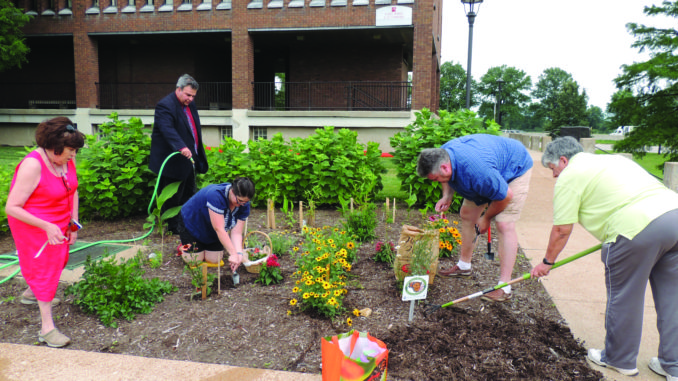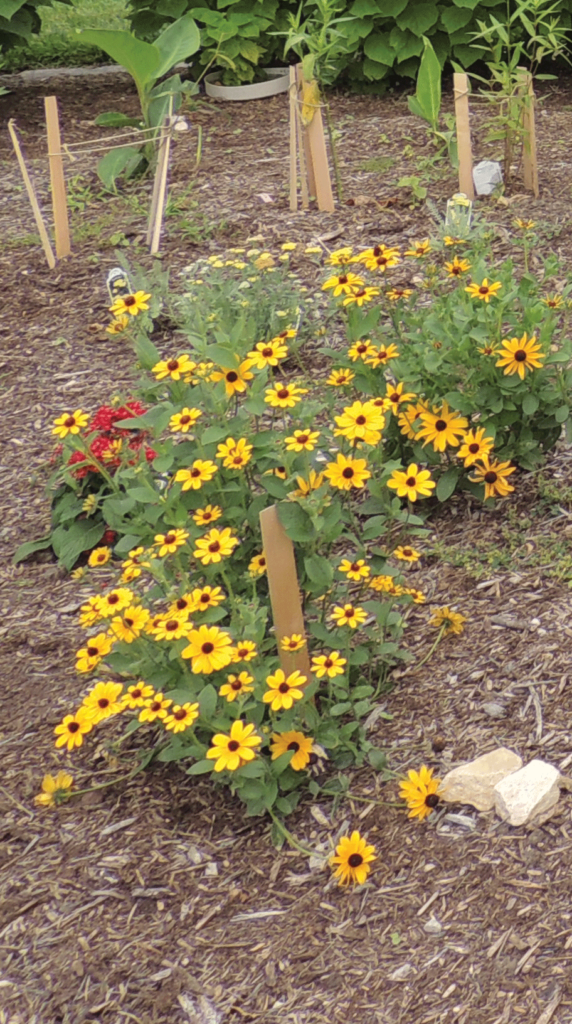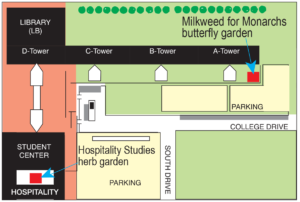
By Chris Cunningham
The Scene staff
Two new gardens are helping to beautify Forest Park’s urban campus.
Faculty and staff members have planted a butterfly garden in front of A Tower, and this is the second summer that produce is being grown in the cafeteria courtyard.
The 20-by-18-foot butterfly garden is a part of the Milkweed for Monarchs Initiative, which is designed to boost declining monarch butterfly populations.
“It’s nice to know you are prolonging something’s existence,” said Carol Foreman, 64, fine and performing arts secretary. “We all like butterflies, and as a little kid, you think monarchs are the most beautiful.”
Foreman is one of five faculty and staff members who volunteer in the garden regularly. She’s been gardening on and off for 30 years with varying success and wants to get better.
Other volunteers are Humanities Secretary Mary Kearny, English Professor Daniel Yezbick, Writing Center Instructor Toby Knoll and English Instructor Michelle Parrinello-Cason. They work in shifts at watering, weeding and record-keeping.
Kearny grows vegetables and flowers at home. She sees the hobby as a “wonderful transition” between workdays and evenings. The monarch garden adds an activist element.
“It gives the college a chance to be a part of the community in a different way,” Kearny said.
The garden contains daises, parsley, cannas, cone flowers, tiger eyes, black-eyed Susans and perennial, swamp and wild milkweed.
Monarch butterflies lay their larvae (caterpillars) exclusively on milkweed because they’re the only ones that eat it. They also feed on the nectar of other plants.

St. Louis Mayor Francis Slay created the Milkweed for Monarchs Initiative last year. The goal was to plant to 250 gardens to commemorate the city’s 250th anniversary. The college is home to one of 148 so far.
Yezbick, 41, pitched the idea of a Forest Park garden to the International Committee. He had heard about the initiative at a Missouri Botanical Garden workshop titled “Nature in our Neighborhood.”
“Every other campus has a garden,” he said. “Flo Valley has acres of garden, and Wildwood practically is a garden. We were the only campus that didn’t have one.
“In a lot of ways, our campus needs it more than any other, because we are in a very urban environment with lots of concrete.”
Monarch butterflies are considered important to agriculture because they pollinate many plants.
In recent years, the number of monarchs has been shrinking in Oyamel fir forests in central Mexico. Their habitat dropped from 9.93 acres in 2010 to 1.65 acres in 2013, according to the Washington Post.
“Einstein said if all the pollinators go away, you can give humanity 10 years,” Yezbick said. “It is important to preserve that delicate relationship with nature, so the more butterfly gardens, the better.”
Faculty and staff members will invite Forest Park students to be garden volunteers in the future, but they want to get on their feet first. Kearney pointed out it will be a great learning opportunity.
“It is a way for science students to see growth process, but it is also an opportunity to foster personal discipline,” she said. “If it is your day to water plants, it is your personal responsibility to do so.”
In addition to the butterfly garden, herbs and vegetables are being grown in an atrium in the courtyard between the Student Center and Hospitality Studies building. They’re being used by culinary classes.
Biology Professor Angela NewMyer, 37, serves on the board that oversees the atrium.

“We are focused on what the culinary students need for their education,” she said. “We are also using different aspects of the garden to teach students things like composting, which is routed in the science of microbiology.”
The atrium contains eight large pots of Roma tomatoes, mint, bush squash, basil, chives, parsley and sweet peppers.
The board hopes to receive a Gateway Greening grant to buy equipment and expand the garden. If that happens, student volunteers will join the effort in 2016.
“The atrium is an experimental garden,” said Kearney, who also is involved in that project. “Yet it presents opportunities for expansion in terms of the small, urban garden plots that can be prototypes for city dwellers with small yards.”
Campus administration has been “very supportive” of both the butterfly garden and produce garden, according to Yezbick. The building and grounds department loaned equipment.
Yezbick has been known to water the garden in a suit and tie. Sometimes passersby offer to help.
“No matter what garden it is, every time I am out there, somebody comes out and wants to help,” Yezbick said. “It’s amazing how a plant inspires partnership. It is really encouraging.”
